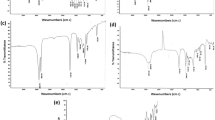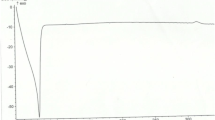Abstract
Purpose
Fat from Capra hircus (goat fat) has been widely used for drug delivery.
Methods
In this work, 1:1, 1:2, and 2:1 of goat fat and Softisan® 142 were melted together, cooled at room temperature, and the resultant matrix further modified with Phospholipon 90G (4:1) to obtain solidified reverse micellar solutions (SRMS). SRMS were used to prepare solid lipid microparticles (SLMs) loaded with or without glibenclamide, a poorly water soluble antidiabetic drug by hot melt homogenization. Particle size, morphology, thermal behavior, drug encapsulation efficiency, in vitro release study, and in vivo fate in diabetogenic rats were investigated.
Results
We report here an improved drug holding capacity (70.35%) of the lipid matrix of SRMS 2:1 due to imperfection of the lipid mixtures showing lower transition temperatures (117.0 °C) and enthalpies (−12.5 mW/mg). In vitro drug diffusion showed 66.98% drug release from SLM 2:1 exhibiting non-Fickian diffusion model (anomalous behavior) and almost zero-order kinetic. SLM 2:1 also gradually released 56.98% of glibenclamide under 16 h and maintained a steady state till 24 h; generally lowering blood glucose from 600 to 120 mg/dL unlike SLM 1:2 which showed burst glibenclamide release of 22.66% within 30 min with consequent rise in blood sugar.
Conclusion
The 2:1 micellar solution (SRMS) of homolipids could deliver glibenclamide in a sustained form better than the conventional tablet form.






Similar content being viewed by others
References
Fouad EA, El-badry M, Mahrous GM, Alsarra IA, Alashbban Z, Alanazi FK. In vitro investigation for embedding dextromethorphan in lipids using spray drying. Digest J Nanomat Biostruct. 2011;6(3):1129–39.
Fricker G, Kromp T, Wendel A, Blume A, Zirkel J, Rebmann H, et al. Phospholipids and lipid-based formulations in oral drug delivery. Pharm Res. 2010;27:1469–86.
Schneeweis A, Muller-Goymann CC. Controlled release of solid reversed micellar-solution (SRMS) suppositories containing metoclopramide-HCl. Int J Pharm. 2000;196:193–6.
Nnamani PO. Formulation and evaluation of solid lipid microparticles containing classes II and III drugs based on biopharmaceutics classification system (BCS). Ph.D thesis, University of Nigeria Nsukka; 2010.
Nnamani PO, Ibezim EC, Attama AA. Adikwu MU New approach to solid lipid microparticles using biocompatible homolipids-templated heterolipid microcarriers for cimetidine delivery. Nig J Pharm Res. 2010;8(1):92–111.
Friedrich I, Muller-Goymann CC. Characterization of solidified reverse micellar solutions (SRMS) and production development of SRMS based nanosuspensions. Eur J Pharm Biopharm. 2003;56:111–9.
Nnamani PO, Kenechukwu FC, Dibua EU, Ogbonn CC, Monemeh UL, Attama AA. Transdermal microgels of gentamicin. Eur J Pharm Biopharm. 2013;84:345–54.
Nnamani PO, Attama AA, Ibezim EC, Adikwu MU. SRMS 142-based solid lipid microparticles: application in oral delivery of glibenclamide to diabetic rats. Eur J Pharm Biopharm. 2010;76:68–74.
Attama AA, Müller-Goymann CC. Investigation of surface modified solid lipid nanocontainers formulated with a heterolipid templated homolipid. Int J Pharm. 2007;334:179–89.
Attama AA, Schicke BC, Paepenmüller T, Müller-Goymann CC. Solid lipid nanodispersions containing mixed lipid core and a polar heterolipid: characterization. Eur J Pharm Biopharm. 2007;67:48–57.
Attama AA, Onugu CO, Nnamani PO, Adikwu MU, Nzekwe IT. The use of self-emulsifying systems in the delivery of diclofenac. Int J Pharm. 2003;262:23–8.
Soukharev AR. Stability of lipid excipients in solid ipid nanoparticles. Adv Drug Deliv Rev. 2007;59(6):411–8.
Attama AA, Nkemnele MO. In vitro evaluation of drug release from self-micro-emulsifying drug delivery systems using a biodegradable homolipid from Capra hircus. Int J Pharm. 2005;304:4–10.
Nnamani PO, Attama AA, Kenechukwu FC, Ibezim EC, Adikwu MU. Pharmacodynamics of piroxicam from novel solid lipid microparticles formulated with homolipids from Bos indicus. Curr Drug Deliv. 2013;10(6):645–55. https://doi.org/10.2174/156720181006131125145712.
Gabizon A, Catane R, Uziely B, Kaufman B, Tamar S, Cohen R, et al. Prolonged circulation time and enhanced accumulation in malignant exudates of doxorubicin encapsulation in polyethylene glycol coated liposomes. Cancer Res. 1994;54:987–92.
Huang SK, Mayhew E, Gilani S, Lasic DD, Martin FJ, Papahadjopoulos D. Pharmacokinetics and therapeutics of sterically stabilized liposomes in mice bearing C-26 colon carcinoma. Cancer Res. 1994;52:6774–81.
Attama AA, Muller-Goymann CC. A critical study of novel physically structured lipid matrices composed of a homolipid from Capra hircus and theobroma oil. Int J Pharm. 2006;322:67–78.
Nnamani PO, Ibezim EC, Attama AA, Adikwu MU. Surface modified solid lipid microparticles based on homolipids and softisan® 142: preliminary characterization. Asian Pacif J Trop Med. 2010;3(3):205–10.
Toongsuwan S, Li CK, Erickson BK, Chang HC. Formulation and characterization of bupivacaine lipospheres. Int J Pharm. 2004;280(1–2):57–65.
Friedrich I, Reichl S, Muller-Goymann CC. Drug release and permeation studies of nanosuspensions based on solidified reverse micellar solutions (SRMS). Int J Pharm. 2005;305:167–75.
Chime SA, Attama AA, Builders PF, Onunkwo GC. Sustained release diclofenac potassium-loaded solid lipid microparticle based on solidified reverse micellar solution: in vitro and in vivo evaluation. J Microencapsul. 2012:1–11. https://doi.org/10.3109/02652048.2012.726284.
Umeyor CE, Kenechukwu FC, Ogbonna JDN, Chime SA, Attama AA. Investigation of solidified reverse micellar systems as novel carriers for oral delivery of gentamicin. J Pharm Res. 2012;5:4914–20.
Sastry M. Nanostructured thin films by self-assembly of surface modified colloidal particles. Curr Sci. 2000;78:1089–97.
Nnamani PO, Ugwu AA, Nnadi OH, Kenechukwu FC, Ofokansi KC, Attama AA, Lehr CM. Formulation and evaluation of transdermal nanogel for delivery of artemether. Drug Deliv Transl Res. 2021. First online.https://doi.org/10.1007/s13346-021-00951-4.
Attama AA, Schicke BC, Müller-Goymann CC. Further characterization of theobroma oil beeswax admixtures as lipid matrices for improved drug delivery systems. Eur J Pharm Biopharm. 2006;64:294–306.
Andrianov AK, Payne LG. Polymeric carriers for oral uptake of microparticulates. Adv Drug Deliv Rev. 1998;34:155–70.
Eldridge JH, Hammond CJ, Meulbroek JA, Staas JK, Gilley RM, Ticet R. Controlled vaccine release in the gut-associated lymphoid tissues. I. Orally administered biodegradable microspheres target the Peyer’s patches. J Control Rel. 1990;11:205–14.
Swartz MA. The physiology of the lymphatic system. Adv Drug Deliv Rev. 2001;50:3–20.
Kreuter J. Peroral administration of nanoparticles. Adv Drug Deliv Rev. 1991;7:71–86.
Florence AT, Hillery AM, Hussain N, Jani PU. Nanoparticles as carriers for oral peptide absorption: studies on particle uptake and fate. J Control Rel. 1995;36:39–46.
Florence AT, Hillery M, Jani PU. Factors affecting the oral uptake and translocation of polystyrene nanoparticles: histological and analytical evidence. J Drug Target. 1995;3:65–70.
Cavalli R, Bargoni A, Podio V, Muntoni E, Zara GP, Gasco MR. Duodenal administration of solid lipid nanoparticles loaded with different percentages of tobramycin. J Pharm Sci. 2003;92:1085–94.
Acknowledgements
We thank Phospholipid GmbH Kӧln, Germany, BASF Ludwigshafen, Germany, and Gattefossé, St. Priest, France, for gift samples of Phospholipon® 90G. We equally thank JUHEL Pharmaceuticals for the gift sample of glibenclamide.
Author information
Authors and Affiliations
Corresponding author
Ethics declarations
Statement of Animal Rights and Use Protocols
All applicable international, national, and/or institutional guidelines for the care and use of animals were followed. The animal studies were performed after receiving approval of the Animal Care and Use Committee of the Faculty of Pharmaceutical Sciences (ethical approval number: FP/PT/019/A/010). Clinically normal male albino Wistar rats weighing 200 ± 10 g, procured from the animal breeding center, Department of Pharmacology and Toxicology, Faculty of Pharmaceutical Sciences, University of Nigeria, Nsukka and housed in a regulated environment (25 ± 2 °C, 12 h light/dark cycle, light period starting at 7 am), acclimatized for 1 week prior to study and provided free access to standard rodent pellets (Guinea feeds Ltd Nigeria) and water in clean glass water bottles ad libitum, were used for the experiment. All animal experiments complied with the ARRIVE guidelines and were performed in accordance with the U.K. Animals (Scientific Procedures) Act, 1986 and associated guidelines, EU Directive 2010/63/EU for animal experiments. Cage-side clinical observations of the rats were made throughout the study period. The rats were divided into nine groups of five rats each and fasted overnight prior to the induction of diabetes mellitus.
Conflict of Interest
The authors declare no competing interests.
Additional information
Publisher's Note
Springer Nature remains neutral with regard to jurisdictional claims in published maps and institutional affiliations.
Supplementary Information
Below is the link to the electronic supplementary material.
Rights and permissions
About this article
Cite this article
Nnamani, P.O., Ibezim, E.C., Adikwu, M.U. et al. Sustained-Release Glibenclamide-Loaded Solid Lipid Microparticles from Micellar Solutions of Homolipids. J Pharm Innov 17, 701–711 (2022). https://doi.org/10.1007/s12247-021-09554-5
Accepted:
Published:
Issue Date:
DOI: https://doi.org/10.1007/s12247-021-09554-5




